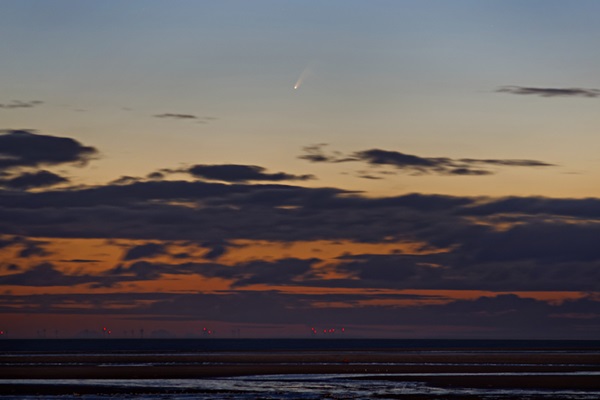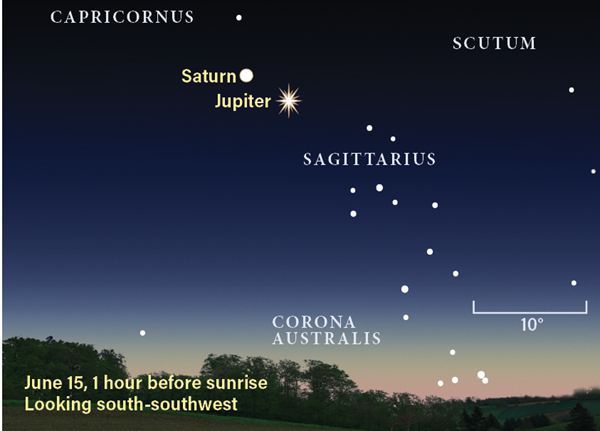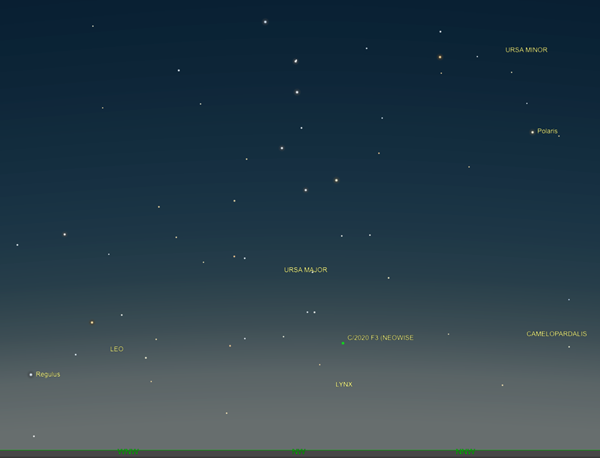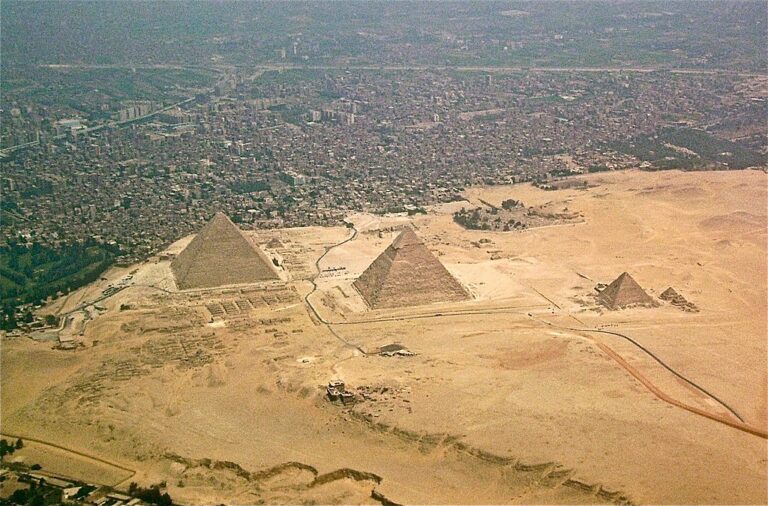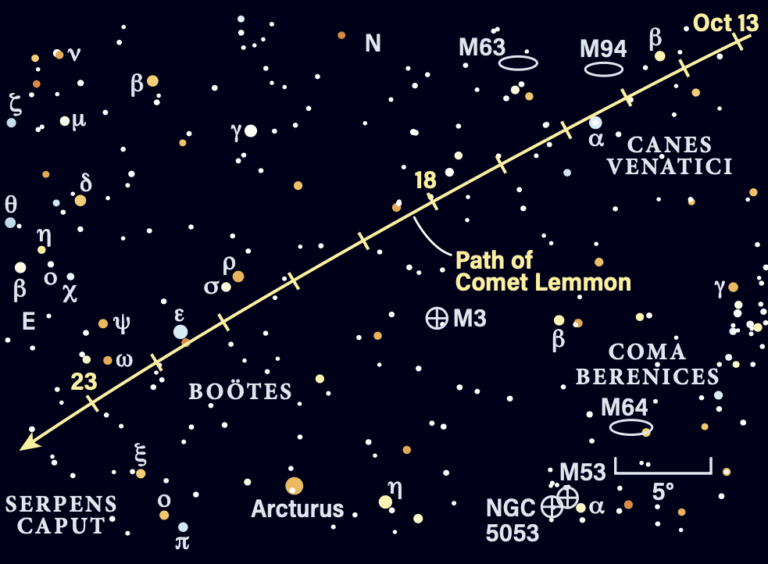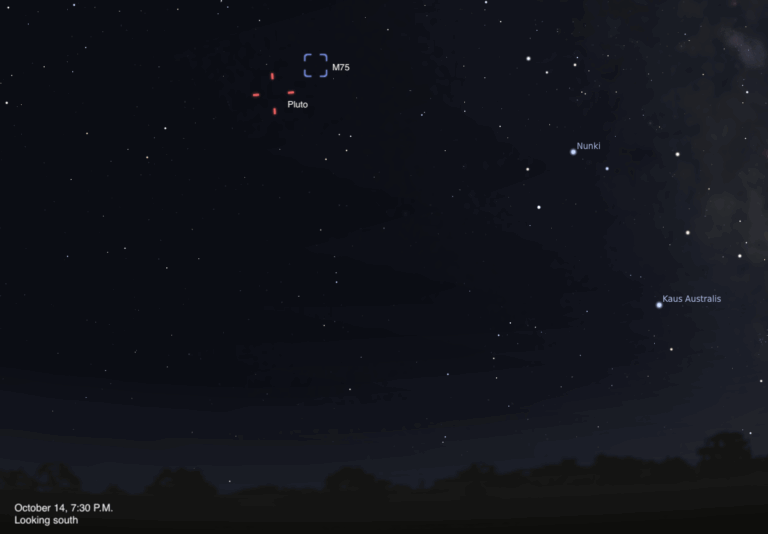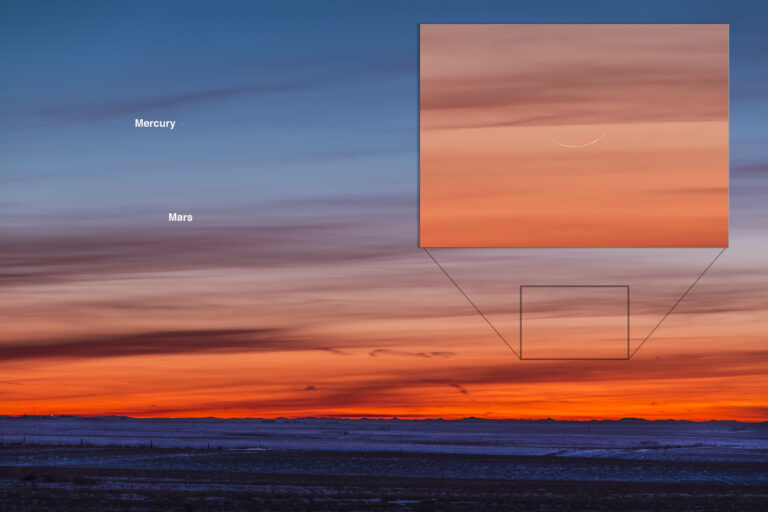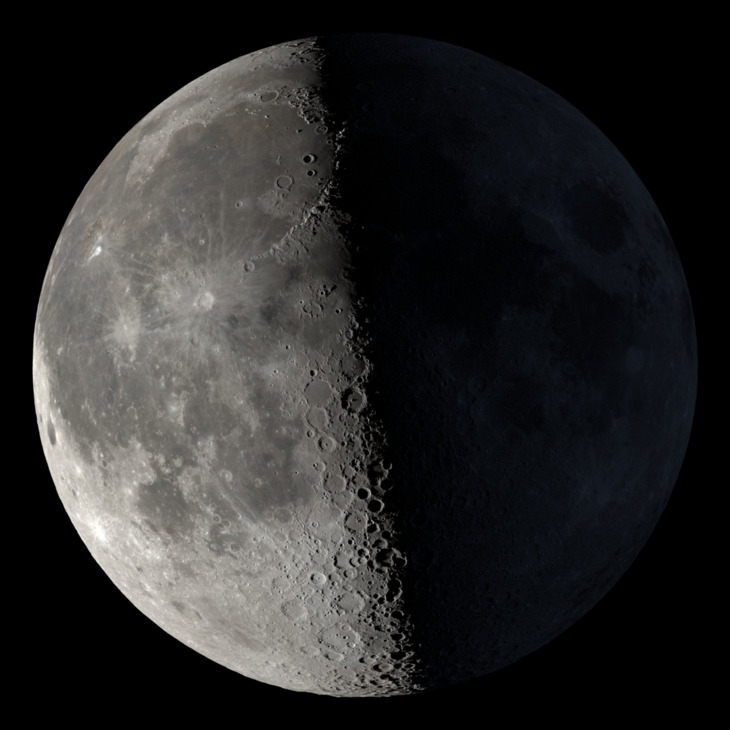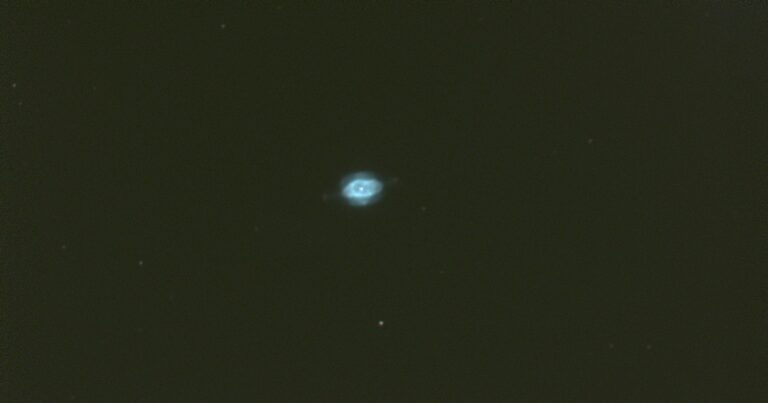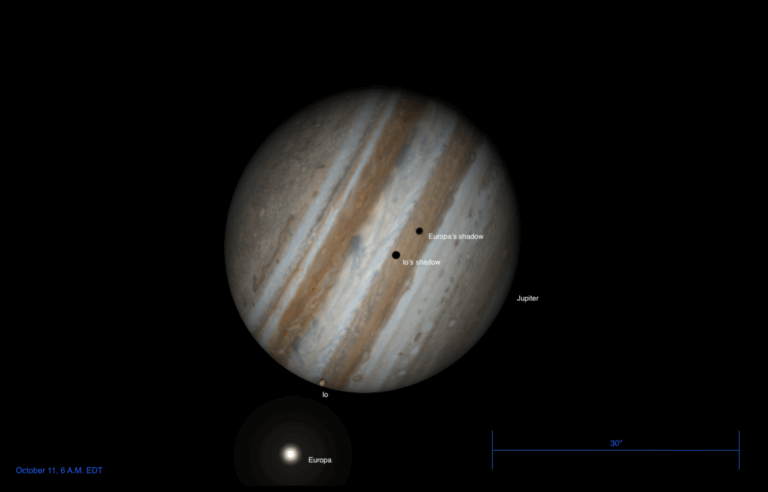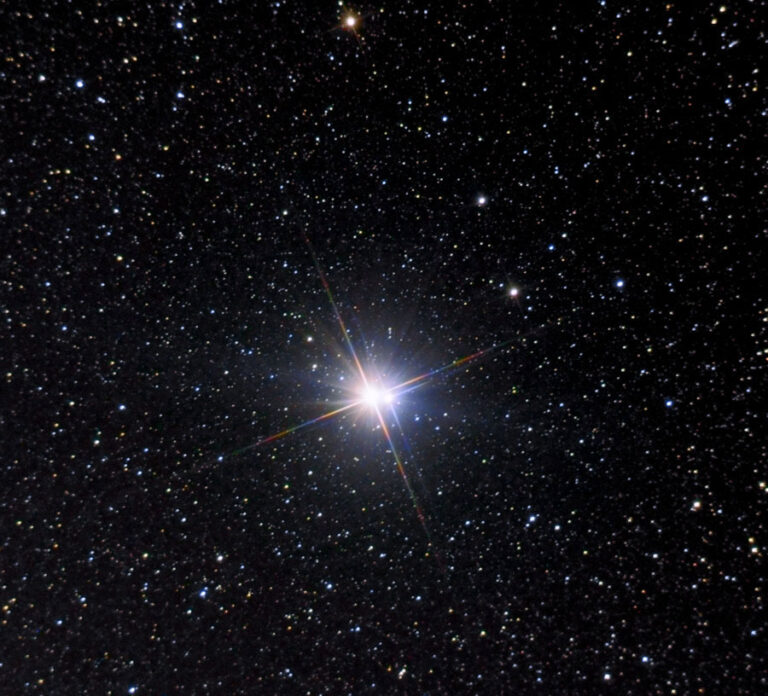Key Takeaways:
Set your sights on the bright star Arcturus tonight. The alpha star of Boötes the Herdsman, Arcturus is roughly magnitude –0.05 and situated high above the western horizon after dark. One of the easiest ways to find it is to locate the Big Dipper, then follow the curve of its handle to “arc to Arcturus.” The orange-hued luminary’s name means “Bear Watcher” — a title that certainly makes sense, given its close proximity behind Ursa Major. This large, aging star shines more than 110 times brighter than our Sun in visible light. If placed in the center of our solar system, Arcturus would reach a quarter of the way to Mercury. Some astronomers have theorized that, based on its composition and motion, the star may not have been born in the Milky Way, but instead absorbed when our galaxy ate a doomed satellite between 5 billion and 8 billion years ago.
Saturday, July 11
Now is a great time to try and glimpse 2020’s first naked-eye comet, C/2020 F3 (NEOWISE), in the morning sky. An hour before sunrise, the comet is about 10° high in the northeast, less than 17° east of the bright star Capella in Auriga. The comet should be around magnitude 1.5 to 1.7, easily visible without aid under relatively clear skies. In more light-polluted areas or as dawn approaches, binoculars or a small scope will bring it into view, along with its several-degrees-long tail. Optical aid should also help you better resolve the comet’s coma, roughly 3.6′ across, leading the fanlike tail — reminiscent of Comet C/1975 V1 (West) in the mid-1970s, according to astrophotographer Chris Schur.
Discovered in March by NASA’s Near Earth Asteroid Wide-field Infrared Survey Explorer (NEOWISE) spacecraft, the comet passed perihelion, the closest point to the Sun in its orbit, on July 3. It quickly rose to naked-eye visibility around this time and should continue to delight for the rest of the month. The comet’s closest approach to Earth will occur on July 23, when it comes within 0.69 astronomical units (64.1 million miles [103.2 million kilometers]) of our planet.
In just a few days, NEOWISE will also begin appearing in the evening sky, offering yet more chances to enjoy the spectacular sight.
The Moon passes 2° south of Mars at 4 P.M. EDT. This morning, you can catch them 6° apart an hour before sunrise in Cetus the Whale, high above the southeast horizon.

Astronomy is pleased to present The Complete Star Atlas, the perfect resource for stargazers of all ages. This practical guide to viewing the night sky is now available, and includes approximately 87,000 stars, 1,200 deep-sky objects, and 24 high-quality star maps. You’ll also find 50 pages of astronomy history, tips, and more from experienced Contributing Editor Michael E. Bakich.
Mercury, currently in Gemini the Twins, is stationary at 3 A.M. EDT. It will now begin tracking east relative to the background stars, moving toward Cancer the Crab, which it will enter early next month. The planet is only about 3° high in the east half an hour before sunrise this morning. It will continue rising earlier in the days to come, so if it’s too hard to catch now, just wait.
Venus passes 1° north of Aldebaran at 3 A.M. EDT. The pair are still below the horizon at this time, but should become visible within two hours, around 5 A.M. EDT, steadily rising higher. An hour before sunrise, the pair is 16° high.
Venus reached greatest brilliancy a mere two days ago and continues to shine at magnitude –4.7. Its disk is now 29 percent illuminated and is 36″ wide.
The Moon reaches apogee, the farthest point from Earth in its orbit, at 3:27 P.M. EDT. At that time, our satellite will lie 251,158 miles (404,200 kilometers) from our planet. Last Quarter Moon occurs a few hours later, at 7:29 P.M. EDT.
The dwarf planet Ceres — the largest object in the main asteroid belt — is stationary at 10 P.M. EDT in Aquarius. It will now slowly track toward the southwest, toward a magnitude 3.7 star known as 88 Aquarii or c2 Aquarii in the Water Bearer.
If you’ve got a clear view to the south, try finding M24, also known as the Sagittarius Star Cloud, near the plane of the Milky Way tonight. It’s located just above the bow of Sagittarius the Archer and covers about 1.5°. Discovered in 1764, this gauzy grouping of stars is visible to the naked eye under good conditions, with detail more easily made out using binoculars or a small telescope. Despite its name, the Star Cloud is not actually a cloud, a galaxy, a nebula, or even a star cluster — it’s really a gap in the dark, dusty plane of the Milky Way where there is simply less dust present, letting us see all the way to the distant Sagittarius spiral arm. Imagers will likely spot the red-hued emission nebula IC 1284, which lies nearby, in wider shots.
Jupiter reaches opposition at 4 A.M. EDT. At that time, the gas giant will sit 385 million miles (619 million km) from Earth. You can catch it this morning in the southwestern sky, blazing at magnitude –2.8 in the constellation Sagittarius. Its disk spans 48″ and at the time of opposition, all four of its Galilean moons will be on display. But act fast — by 4:17 A.M. EDT, Europa will disappear behind the planet’s western limb. It won’t reappear before sunrise.
6.8° east of Jupiter is magnitude 0.1 Saturn, on its way to its own opposition early next week. Its disk currently spans 18″ and its rings stretch nearly 42″ east-west. The nearly 3,000-mile-wide (4,800 km) Cassini Division is on full display.
The Moon passes 4° south of Uranus at 8 A.M. EDT. You can catch the magnitude 5.8 ice giant easily with binoculars or a small scope in the predawn hours. It currently lies in Aries, roughly halfway along an invisible line drawn between the bright stars Hamal and Menkar. An hour before sunrise, Earth’s satellite has already approached to within 10.8° of the planet, lying directly east of the ice giant.
Today also marks the 55th anniversary of Mariner 4’s flyby of Mars — the first successful Red Planet flyby ever achieved. It is the 5th anniversary of New Horizons’ flyby of Pluto, also the first of its kind.
Pluto reaches opposition tomorrow afternoon, so keep scrolling to find out how to observe it.
Wednesday, July 15
Pluto reaches opposition at 3 P.M. EDT. The tiny world shines at magnitude 14.3 and is 3.07 billion miles (4.95 billion km) from Earth. Nestled close to Jupiter and Saturn in the sky, Pluto is visible all night, with the best viewing later in the evening and early into tomorrow morning, when it’s highest above the horizon.
To find it, center bright Jupiter in your scope — you can’t miss it. Pluto is about 1.8° east-southeast of the gas giant, with a disk less than an arcsecond across. If you can spot it visually, it will simply appear as a dim, dull “star.” Imaging through larger scopes with even a simple digital camera should help reveal it.
The New Horizons flyby, now five years ago, revolutionized our understanding of the dwarf planet. Although the spacecraft’s brief visit is long over, its data is still revealing new details, including the possibility that Pluto formed “hot” through collisions, rather than through “cold” material slowly building up over time in the outer solar system.

Are you ready to see what New Horizons learned at Pluto? Check out our free downloadable eBook, The strange, icy world of Pluto to learn more about the groundbreaking mission to this distant world.
C/2020 F3 (NEOWISE) should now be readily visible in the evening sky, soaring nearly 15° high in the northwest an hour after sunset. It will remain well above the horizon for those at northern latitudes for the next few hours. To get the best seeing, or atmospheric steadiness — which diminishes toward the horizon — you’ll want to observe as soon as darkness begins to fall. The comet has left Auriga and is now in Lynx; tonight, it’s about 26° west (below) the easily identifiable cup of the Big Dipper as the asterism sits sideways in the sky with its handle pointing upward early in the evening.
Friday, July 17
The Moon passes 3° north of Venus at 3 A.M. EDT. Two hours later, most observers should be able to catch the pair about 10° above the horizon, with Venus hanging between and just below our Moon and the bright star Aldebaran in Taurus the Bull. The waning Moon is a mere 12-percent-lit crescent; Venus has it slightly beat, now a 33-percent-lit crescent. Just northwest of the planet is the loose open Hyades star cluster, which spans roughly 5.5°.
Today also marks the 45th anniversary of the Apollo-Soyuz link-up in Earth orbit, the first international space mission. Three American astronauts aboard an Apollo capsule and two Soviet cosmonauts in a Soyuz spacecraft launched hours apart from the U.S. and Kazakhstan on July 15, 1975. Two days later, on the 17th, the craft rendezvoused; the spacecraft hard docked at 12:12 P.M. EDT and about three hours later, at 3:17 P.M. EDT, the crews met.

